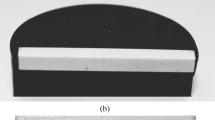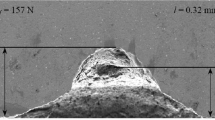Abstract
In this work, the influence of crack forms [radial crack (RC) and half-penny crack (HPC)] on indentation hardness test results of ceramic materials (W e/W t = 0.3–0.7) was studied by finite element analysis and verified by experiments. Excluding the influence of size effect, the values of HPC and RC indentation hardness from instrumented indentation tests on five ceramic materials (Si3N4, ZrO2, ZTA, Al2O3, and silica) were compared with that of “Non-Crack” indentation hardness. The results show that the influence of RC or HPC on indentation hardness test results of isotropic and homogeneous ceramic materials is verified to be negligible, both analytically and experimentally. But the “Pop-in phenomenon” is found to have a great impact on indentation hardness test results for ceramic materials. Therefore, in the absence of “Pop-in phenomenon,” the test results of indentation hardness of ceramic materials were practically reliable. This work provides a theoretical foundation for further study on instrumented indentation for determining the elastic–plastic properties and fracture toughness of ceramic materials.








Similar content being viewed by others
References
Sakharova NA, Oliveira MC, Antunes JM et al (2013) On the determination of the film hardness in hard film/substrate composites using depth-sensing indentation. Ceram Int 39:6251–6263
Liao YG, Zhou YC, Huang YL et al (2009) Measuring elastic–plastic properties of thin films on elastic–plastic substrates by sharp indentation. Mech Mater 41:308–318
Toparli M, Koksal NS (2005) Hardness and yield strength of dentin from simulated nano-indentation tests. Comput Methods Programs Biomed 77:253–257
Randall NX, Vandamme M, Ulm FJ (2009) Nanoindentation analysis as a two-dimensional tool for mapping the mechanical properties of complex surfaces. J Mater Res 24:679–690
Li YP, Zhu XF, Tan J et al (2009) Comparative investigation of strength and plastic instability in Cu/Au and Cu/Cr multilayers by indentation. J Mater Res 24:728–735
Wei Z, Zhang G, Chen H et al (2009) A simple method for evaluating elastic modulus of thin films by nanoindentation. J Mater Res 24:801–815
Rocio S, Cisilino Adrian P et al (2011) Determination of the Drucker–Prager parameters of polymers exhibiting pressure-sensitive plastic behaviour by depth-sensing indentation. Int J Mech Sci 53:471–478
Alemdar H, Zahir M (2012) Fast inversion algorithm for identification of elastoplastic properties of power hardening materials from limited spherical indentation tests. Int J Nonlin Mech 47:526–536
Oliver WC, Pharr GM (1992) An improved technique for determining hardness and elastic modulus using load and displacement sensing indentation experiments. J Mater Res 7:1564–1583
Oliver WC, Pharr GM (2004) Measurement of hardness and elastic modulus by instrumented indentation: advances in understanding and refinements to methodology. J Mater Res 19:3–20
Cheng YT, Cheng CM (1998) Relationships between hardness, elastic modulus, and the work of indentation. Appl Phys Lett 73:614–616
Ma DJ, Ong CW, Zhang TH (2008) An improved energy method for determining Young’s modulus by instrumented indentation using a Berkovich. J Mater Res 23:2106–2115
Ma DJ, Ong CW, Zhang TH (2009) An instrumented indentation method for Young’s modulus measurement with accuracy estimation. Exp Mech 49:719–729
Ma DJ, Ong CW (2010) Further analysis of energy-based indentation relationship among Young’s modulus, nominal hardness, and indentation work. J Mater Res 25:1131–1136
Veprek-Heijman MGJ, Veprek RG, Argon AS et al (2009) Non-linear finite element constitutive modeling of indentation into super- and ultrahard materials: the plastic deformation of the diamond tip and the ratio of hardness to tensile yield strength of super and ultrahard nanocomposites. Surf Coat Technol 203:3385–3391
Hamada AS, Haggag FM, Porter DA (2012) Non-destructive determination of the yield strength and flow properties of high-manganese twinning-induced plasticity steel. Mater Sci Eng A 558:766–770
Evans AG, Charles EA (1976) Fracture toughness determination by indentation. J Am Ceram Soc 59:371–376
Lawn BR, Evans AG, Marshall DB (1980) Elastic/plastic indentation damage in ceramics: the median/radial crack system. J Am Ceram Soc 63:574–581
Anstis GR, Chantikul P, Lawn BR, Marshall DB (1981) A critical evaluation of indentation techniques for measuring fracture toughness: I, direct crack measurements. J Am Ceram Soc 64:533–538
Gong JH, Wu JJ, Guan ZD (1999) Analysis of the indentation size effect on the apparent hardness for ceramics. Mater Lett 38:197–201
Peng ZJ, Gong JH, Miao H (2004) On the description of indentation size effect in hardness testing for ceramics: analysis of the nanoindentation data. J Eur Ceram Soc 24:2193–2201
Gong JH, Wu JJ, Guan ZD (1999) Examination of the indentation size effect in low-load Vickers hardness testing of ceramics. J Eur Ceram Soc 19:2625–2631
Loshak MG, Aleksandrova LI (2012) The effect of the indentation load on the results of measuring hardness of superhard materials. J Superhard Mater 34:305–307
Schiffmann KI (2011) Determination of fracture toughness of bulk materials and thin films by nanoindentation: comparison of different models. Philos Mag 91:1163–1178
Yonezu A, Xu B, Chen X (2009) Indentation induced lateral crack in ceramics with surface hardening. Mater Sci Eng A 507:226–235
Burghard Z, Zimmermann A, Rodel J et al (2004) Crack opening profiles of indentation cracks in normal and anomalous glasses. Acta Mater 52:293–297
Lube T (2001) Indentation crack profiles in silicon nitride. J Eur Ceram Soc 21:211–218
Wilantewicz TE, Varner JR (2008) Indentation crack initiation behavior of vitreous silica glasses containing different hydroxyl concentration. J Non-Cryst Solids 354:1553–1558
Zeng KY, Rowcligge D (1994) Experimental measurement of residual stress field around a sharp indentation in glass. J Am Ceram Soc 77:524–530
Anunmana C, Anusavice KJ, Mecholsky JJ (2009) Residual stress in glass: indentation crack and fractography approaches. Dent Mater 25:1453–1458
Zhang TY, Chen LQ, Fu R (1999) Measurements of residual stresses in thin films deposited on silicon wafers by indentation fracture. Acta Mater 47:3869–3878
Palmqvist S (1957) A method to determine the fracture toughness brittle materials, especially hard metals. Jenkontorets Ann 141:303–307
Tang Y, Yonezu A, Ogasawara N et al (2008) On radial crack and half-penny crack induced by Vickers indentation. Proc R Soc A 464:2967–2984
Maschio RD, Maddalena A, Calliari I (1984) Radial crack initiation in glass by Vickers indentation. Mater Chem Phys 11:443–451
Tanaka M (1996) Fracture toughness and crack morphology in indentation fracture of brittle materials. J Mater Sci 31:749–755. doi:10.1007/BF00367895
Niihara K, Morena R, Hasselman DPH (1982) Evaluation of K IC of brittle solids by the indentation method with low crack-to-indent ratios. J Mater Sci Lett 1:13–16
Lankford J (1982) Indentation microfracture in the Palmqvist crack regime: implications for fracture toughness evaluation by the indentation method. J Mater Sci Lett 1:493–495
Lawn BR, Fuller ER (1975) Equilibrium penny-like cracks in indentation fracture. J Mater Sci 10:2016–2024. doi:10.1007/BF00557479
Wang JL, Ma DJ, Chen W et al (2014) Analysis of pop-in phenomenon in the process of ceramic materials instrumented indentation. Adv Mater Res 941–944:564–568
Oliver DJ, Bradby JE, Williams JS et al (2007) Giant pop-ins and amorphization in germanium during indentation. J Appl Phys 101:1–9
Guicciardi S, Melandri C, Monteverde FT (2010) Characterization of pop-in phenomena and indentation modulus in a polycrystalline ZrB2 ceramic. J Eur Ceram Soc 30:1027–1034
ISO14577-2002 Metallic materials instrumented indentation test for hardness and materials parameter
Antunes JM, Menezes LF, Fernandes JV (2006) Three-dimensional numerical simulation of Vickers indentation tests. Int J Solids Struct 43:784–806
Ma DJ, Song ZK, Guo JH et al (2011) A high precision instrumented indentation tester and the calculation method of diamond indenter press against the sample depth. China Patent CN102288500A, 21 Dec 2011
Acknowledgements
The authors would like to thank Prof. Dejun Ma for helpful discussion. The support from Innovation Foundation of China Academy of Armored Forces Engineering (Projects No. 2013ZBJ03) is also gratefully acknowledged.
Author information
Authors and Affiliations
Corresponding author
Rights and permissions
About this article
Cite this article
Wang, J.L., Ma, D.J. & Sun, L. The influence of crack forms on indentation hardness test results for ceramic materials. J Mater Sci 50, 6096–6102 (2015). https://doi.org/10.1007/s10853-015-9162-2
Received:
Accepted:
Published:
Issue Date:
DOI: https://doi.org/10.1007/s10853-015-9162-2




